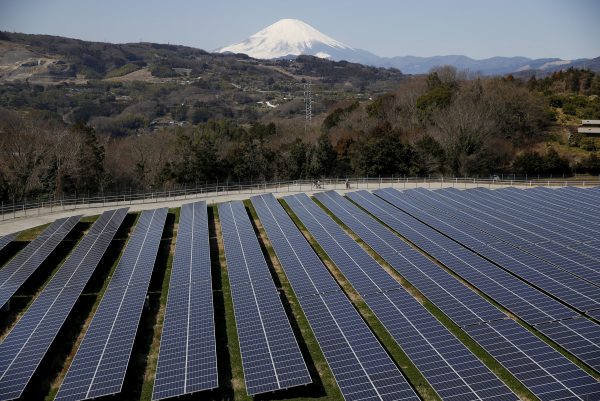Japan’s power system has 10 regional utilities which were previously monopolised by 10 vertically integrated regional utilities. To modernise the energy market, the Japanese government pushed for full liberalisation of the electricity sector and unbundled generation from transmission and distribution services. These developments have allowed new power sources and retailers to enter the electricity market.
The German-style feed-in tariff system introduced in 2012 has led to a rapid expansion of renewables, particularly solar photovoltaic panels. Solar power capacity expanded from 5 GW in 2011 to 62 GW in 2019. The share of renewables in the electricity supply rose from 9–10 per cent in 2011, mostly from large hydropower stations, to 19 per cent in 2019, driven by solar, wind and bioenergy.
Electricity demand has fallen by about 10 per cent. In recent months, with continuous increasing renewables generation and declining consumption brought on by COVID-19, there have been many days where renewables provided close to or over 100 per cent of demand in certain areas.
Recently there has been a great deal of interest in offshore wind development. Investing in offshore wind farms could accelerate the development of backbone power lines and help to resolve the problem of grid connection, which has been a barrier to the large-scale introduction of renewables, including onshore wind.
But even under these circumstances, the future of Japan’s climate policy remains unclear. In line with the Paris Agreement, Japan has committed to reducing greenhouse gases by 26 per cent of 2013 levels in 2030 and 80 per cent in 2050. But so far, no concrete measures have been formulated for 2050, nor has the base year been defined.
Before the Fukushima Nuclear Accident, the government strongly promoted nuclear power as ‘a measure against global warming’, but climate was never a policy priority. In reality, Japan’s energy policy gives priority to incumbent power industries, with nuclear and coal-fired power as the main sources of supply. That’s why the development of onshore wind power has been sluggish and solar power was used only on private rooftops before the introduction of the feed-in tariff scheme.
The latest energy policy is that the electricity mix in 2030 will be 27 per cent gas, 26 per cent coal, 3 per cent oil, 22–24 per cent renewables, and 20–22 per cent nuclear. This is not only fossil fuel-driven — it is also infeasible.
Of the 54 nuclear reactors that were in operation before the Fukushima accident, 24 have shut down. Of the remaining 30, some have not applied for compliance with the new regulatory standards, some have struggled to meet these standards, some have passed but are yet to be accepted by local governments and others will reach the end of their 40-year lifetime before 2030. Since 2011, the government and power companies have reopened nine reactors accounting for 5–6 per cent of national electricity production. Under these circumstances, even half of the 2030 target will be difficult to achieve.
Coal-fired power had already reached 32 per cent of Japan’s energy mix in 2018. The lack of carbon pricing and other effective measures against carbon emissions has led to the introduction of several new coal plants since 2011, providing around 5.4 GW of capacity. Another 8–9GW is under construction.
The government recently announced that 100 units, or 90 per cent, of old and inefficient coal-fired plants, will be closed by 2030 but their closure will only reduce overall installed capacity by around 20 per cent. The government has announced that it will proceed with ‘high efficiency’ coal-fired plants such as Ultra Super Critical (USC) or Integrated Coal Gasification Combined Cycle (IGCC), but these plants produce almost the same amount of emissions as those ‘inefficient plants’ being shut down. Coal-fired plants are still expected to provide over 30 GW of electricity to the grid in 2030.
If this trend continues, renewables capacity may increase but fossil fuels will remain the key source of power. Japan will not meet its reduction targets for 2030 and 2050.
The biggest problem is that Japan lacks a vision for energy transition and a decarbonised society. Post-COVID-19 stimulus packages should centre on green stimulus policies for energy transition and digitisation, as in European countries and South Korea. Yet out of the supplementary budget of about 30 trillion yen (US$280 billion), only 5 billion yen (US$47 million) has been allocated towards green energy initiatives.
Japan’s renewable energy costs — by far the highest among OECD countries — continue to fall in line with global trends. A best-case scenario predicts solar and wind to become the cheapest of all new power sources in Japan by the mid-2020s. This is due to improvements in the grid operations, updated technical regulations, digitalisation of power markets and improved construction technology.
But this trend must be accelerated and placed at the centre of Japan’s economy.
To that end, Japan should send a clear signal to the market by reviewing the energy targets for 2030 and drawing up a policy to achieve a decarbonised society by 2050. A long-term government strategy and a market framework based on fair competition can provide the business sector with the means to implement an energy transition. This is the only way forward for Japan.
Mika Ohbayashi is Director of the Renewable Energy Institute, Tokyo.
This article appears in the most recent edition of East Asia Forum Quarterly, ‘Japan’s Choices’, Vol. 12, No 3.

